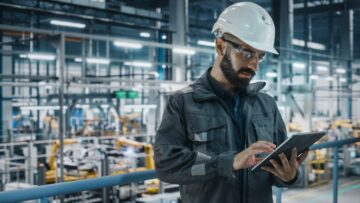
The construction industry, known for its significant carbon footprint, has played a crucial role in global economies. However, in 2017, heavy industry and manufacturing surpassed agriculture, buildings, energy, and transportation in terms of greenhouse gas emissions. Despite this alarming reality, there is a glimmer of hope within this challenging landscape. Several industry giants are pushing against the current and making strides to reduce their impact. In this article, we will spotlight the three leaders in this sector: Thyssen Krupp, Heidelberg Cement, and Cemex.
Thyssen Krupp: Navigating Towards A Greener Tomorrow
Thyssen Krupp, a titan in the shipbuilding and materials industry, is making monumental commitments to sustainability. They are steering their ship towards climate neutrality by 2045. This means they are looking beyond their carbon emissions, also eliminating other greenhouse gas emissions from their supply chain.
Here’s a look at some key aspects of Thyssen Krupp’s sustainability commitment:
- A bold goal to reduce emissions from their facilities and electricity use by 30% by 2030.
- A pledge to reduce emissions from customer product usage by 16%
- A dedication to leveraging more efficient technologies and practices.
- An emphasis on research and development to create less CO2-intensive products.
- Implementation of robust emission reduction programs across all global operations.
This multi-pronged strategy demonstrates their commitment to making a tangible difference in the fight against climate change.
Heidelberg Cement: Concrete Plans for a Greener Future
Heidelberg Cement, a behemoth in the global cement industry, is mixing sustainability with their traditional operations. They have set in stone a plan to reduce their greenhouse gas emissions per tonne of cement by 30% compared to 1990 levels by 2025.
Here’s a glance at their strategy for a greener future:
- Energy efficiency improvement by modernizing plants and optimizing processes.
- A commitment to increase the use of alternative fuels, thereby reducing reliance on traditional fossil fuels.
- Promotion of concrete recycling – a sustainable approach to managing construction waste.
- Active exploration of carbon capture, use, and storage technology – a potential game-changer in emission reduction.
- Support for renewable energy projects, showing a willingness to venture beyond their core operations for the greater good.
Their strategy is a blend of sustainable practices and innovative technology, creating a recipe for a more eco-friendly future.
Cemex: Laying the Foundations for a Sustainable Tomorrow
Cemex, a global leader in the building materials industry, is cementing its place as a sustainability leader. They have pledged to reduce CO2 emissions by 35% per tonne of product by 2030.
Here’s a look into Cemex’s sustainability game plan:
- Energy optimization to reduce their overall consumption.
- Use of alternative fuels as a replacement for traditional energy sources.
- Investments in carbon capture, utilization, and storage (CCUS) technology.
- A commitment to research and development to foster the creation of low-carbon products.
- An ultimate goal to deliver net-zero CO2 concrete by 2050.
Cemex’s strategic commitment to sustainability is built on a solid foundation of innovation and environmental responsibility.
The Blueprint for a Sustainable Future
Thyssen Krupp, Heidelberg Cement, and Cemex – these names are paving the path to a greener future in the construction industry. They are not just reducing their carbon footprints; they are setting examples, proving that companies can balance economic success with environmental responsibility.
Changing Tides: How These Companies are Making a Difference
While the commitments made by these three companies are impressive, it’s also important to understand how they are changing the game for heavy industries:
- Integrating sustainability into their core business strategies: They are not treating sustainability as a side project; it is woven into their fundamental business approach.
- Demonstrating profitability alongside environmental responsibility: These companies are dispelling the myth that profitability and sustainability can’t coexist.
- Inspiring other players in the industry: Their efforts are setting standards for other businesses in the industry, influencing them to follow suit.
Leading the Charge, Changing the Game
The footprints of Thyssen Krupp, Heidelberg Cement, and Cemex are already leaving green imprints on the sands of the construction industry. As they march towards sustainability, they are working to prove that meeting sustainability goals won’t have to come at the expense of economic growth.
The road to net-zero is not easy, but with these companies leading the charge, it is clear that the construction industry can be part of the solution rather than the problem.
A Call to Action: Collaborative Solutions for a Sustainable Heavy Industry
The achievements and commitments of Thyssen Krupp, Heidelberg Cement, and Cemex highlight the immense potential for positive change within the construction sector. However, their efforts alone cannot address the magnitude of the climate crisis. It requires collective action from industry leaders, policymakers, and society as a whole.
To build a sustainable future, the construction industry needs to focus on the following key areas:
1. Collaborative Research and Development
Investing in research and development is crucial for the construction industry to transition to low-carbon technologies and practices. Collaboration between industry players, research institutions, and governments can accelerate innovation and drive the development of sustainable solutions. By sharing knowledge, expertise, and resources, stakeholders can collectively work towards finding breakthrough technologies and processes that reduce emissions while maintaining economic viability.
2. Policy Support and Regulatory Frameworks
Governments play a pivotal role in shaping the direction of the heavy industry sector. Policy support and regulatory frameworks that prioritize sustainability and incentivize emission reductions can create an enabling environment for companies to adopt greener practices. Measures such as carbon pricing, tax incentives, and stricter emission standards can drive industry-wide change and level the playing field for sustainable businesses. Collaboration between policymakers, industry leaders, and environmental experts is essential to design effective policies that balance economic growth with environmental protection.
3. Transitioning to Renewable Energy
Energy consumption is a significant contributor to the carbon footprint of heavy industry operations. Transitioning from fossil fuels to renewable energy sources can significantly reduce emissions. Companies can invest in on-site renewable energy generation, such as solar or wind, to power their operations. Additionally, exploring partnerships with renewable energy providers can ensure a reliable and sustainable energy supply. Collaborative initiatives between industry players and energy companies can drive the development of renewable infrastructure, making clean energy more accessible and affordable for the construction industry.
4. Circular Economy and Waste Management
The construction industry generates a substantial amount of waste and by-products. Embracing circular economy principles can help minimize waste and maximize resource efficiency. Companies can implement strategies such as recycling, reusing materials, and adopting closed-loop systems to reduce their environmental impact. Collaboration with suppliers and customers to implement sustainable supply chain practices can also contribute to waste reduction and resource conservation. Furthermore, investing in innovative waste management technologies, such as advanced recycling and waste-to-energy processes, can help mitigate the environmental impact of waste generated by heavy industry operations.
5. Transparency and Accountability
Transparency and accountability are vital for driving sustainable practices in the construction industry. Companies should disclose their carbon emissions, set science-based targets, and regularly report on their progress. This transparency allows stakeholders, including investors, customers, and the general public, to assess a company’s environmental performance and hold them accountable for their commitments. Collaboration with third-party organizations, such as sustainability certifications and rating agencies, can provide independent verification and ensure credibility in reporting.
6. Knowledge Sharing and Capacity Building
Collaboration platforms and industry networks play a crucial role in facilitating knowledge sharing and capacity building. By sharing best practices, lessons learned, and success stories, companies can learn from each other and accelerate their sustainability journeys. Industry associations, trade unions, and non-profit organizations can organize workshops, conferences, and training programs to enhance awareness, knowledge, and skills related to sustainable practices. Collaboration between academia and industry can also foster research and education focused on developing sustainable solutions for the heavy industry.
Embracing a Sustainable Future Together
The path to a sustainable heavy industry requires a collective effort from all stakeholders involved. Thyssen Krupp, Heidelberg Cement, and Cemex are leading the charge and setting an example for others to follow. By integrating sustainability into their core strategies, demonstrating profitability alongside environmental responsibility, and inspiring others in the industry, these companies are reshaping the future of the construction industry.
However, the transformation needs to extend beyond individual companies. It requires collaboration, innovation, and a shared vision for a sustainable future. Governments, industry leaders, investors, employees, and consumers all have a role to play in driving this transition.
Sources:
www.thyssenkrupp.com/en/company/sustainability/climate-strategy-and-targets
www.cemex.com/sustainability/our-2030-targets
www.iea.org/reports/achieving-net-zero-heavy-industry-sectors-in-g7-members/executive-summary
Picture: www.pexels.com/photo/yellow-heavy-equipment-129544/
- SEO Powered Content & PR Distribution. Get Amplified Today.
- EVM Finance. Unified Interface for Decentralized Finance. Access Here.
- Quantum Media Group. IR/PR Amplified. Access Here.
- PlatoAiStream. Web3 Data Intelligence. Knowledge Amplified. Access Here.
- Source: https://carboncreditcapital.com/net-zero-leaders-construction-industry/
- :has
- :is
- :not
- 2017
- 2025
- 2030
- 2050
- 35%
- 49
- 50
- a
- Academia
- accelerate
- accessible
- accountability
- accountable
- achievements
- across
- Action
- Additionally
- address
- adopt
- Adopting
- advanced
- affordable
- against
- agencies
- agriculture
- All
- allows
- alone
- alongside
- already
- also
- alternative
- amount
- an
- and
- approach
- ARE
- areas
- article
- AS
- aspects
- assess
- associations
- At
- awareness
- Balance
- BE
- behemoth
- BEST
- best practices
- between
- Beyond
- Blend
- bold
- breakthrough
- build
- Building
- Building Materials
- built
- business
- businesses
- but
- by
- call
- call to action
- CAN
- cannot
- Capacity
- capital
- capture
- carbon
- carbon capture
- carbon emissions
- carbon footprint
- cementing
- certifications
- chain
- challenging
- change
- changing
- charge
- circular economy
- clean energy
- clear
- Climate
- Climate change
- climate crisis
- co2
- co2 emissions
- collaboration
- collaborative
- Collective
- Collective Action
- collectively
- come
- commitment
- commitments
- Companies
- Company’s
- compared
- conferences
- CONSERVATION
- construction
- Consumers
- consumption
- contribute
- contributor
- Core
- create
- Creating
- creation
- Credibility
- credit
- crisis
- crucial
- Current
- customer
- Customers
- dedication
- deliver
- demonstrates
- demonstrating
- Design
- Despite
- developing
- Development
- difference
- direction
- Disclose
- drive
- driving
- each
- easy
- Eco-friendly
- Economic
- Economic growth
- economies
- economy
- Education
- Effective
- efficiency
- efficient
- effort
- efforts
- electricity
- eliminating
- embracing
- emission
- Emissions
- emphasis
- employees
- enabling
- energy
- energy projects
- enhance
- ensure
- Environment
- environmental
- essential
- example
- examples
- expertise
- experts
- exploration
- Exploring
- extend
- facilitating
- facilities
- field
- fight
- finding
- Focus
- focused
- follow
- following
- Footprint
- For
- fossil
- fossil fuels
- Foster
- Foundation
- Foundations
- frameworks
- from
- fuels
- fundamental
- Furthermore
- future
- game
- game-changer
- GAS
- General
- general public
- generated
- generates
- generation
- Glance
- glimmer
- Global
- goal
- Goals
- good
- Governments
- greater
- Green
- greenhouse gas
- Greenhouse gas emissions
- Growth
- Have
- heavy
- help
- Highlight
- hold
- hope
- How
- However
- http
- HTTPS
- IEA
- immense
- Impact
- implement
- important
- impressive
- improvement
- in
- Incentives
- incentivize
- Including
- Increase
- independent
- individual
- industries
- industry
- influencing
- Infrastructure
- initiatives
- Innovation
- innovative
- innovative technology
- inspiring
- institutions
- Integrating
- into
- Invest
- investing
- Investors
- involved
- IT
- ITS
- Journeys
- jpg
- just
- Key
- Key Areas
- knowledge
- known
- landscape
- leader
- leaders
- leading
- LEARN
- learned
- leaving
- less
- Lessons
- Lessons Learned
- Level
- levels
- leveraging
- LINK
- Look
- looking
- low-carbon
- made
- maintaining
- Making
- management
- managing
- manufacturing
- March
- materials
- Maximize
- means
- measures
- meeting
- Mitigate
- Mixing
- monumental
- more
- more efficient
- names
- navigating
- needs
- net
- net-zero
- networks
- non-profit
- Non-profit Organizations
- of
- on
- Operations
- optimization
- optimizing
- or
- organizations
- Other
- Others
- overall
- part
- partnerships
- path
- Paving
- performance
- pivotal
- Place
- plan
- plans
- plants
- Platforms
- plato
- Plato Data Intelligence
- PlatoData
- Play
- played
- players
- playing
- policies
- policy
- policymakers
- positive
- potential
- power
- practices
- pricing
- principles
- Prioritize
- Problem
- processes
- Product
- Products
- profitability
- Programs
- Progress
- project
- projects
- protection
- Prove
- provide
- providers
- public
- Pushing
- rather
- rating
- Rating agencies
- Reality
- recipe
- recycling
- reduce
- reducing
- reduction
- reductions
- regularly
- regulatory
- related
- reliable
- reliance
- Renewable
- renewable energy
- replacement
- report
- Reporting
- requires
- research
- research and development
- Research Institutions
- resource
- Resources
- responsibility
- road
- robust
- Role
- sector
- set
- setting
- several
- shaping
- shared
- sharing
- should
- showing
- side
- significant
- significantly
- skills
- Society
- solar
- solid
- solution
- Solutions
- some
- Sources
- Spotlight
- stakeholders
- standards
- STONE
- storage
- Stories
- Strategic
- strategies
- Strategy
- stricter
- strides
- substantial
- success
- Success Stories
- such
- Suit
- suppliers
- supply
- supply chain
- support
- surpassed
- Sustainability
- sustainable
- Sustainable Energy
- sustainable future
- Systems
- targets
- tax
- Technologies
- Technology
- terms
- than
- that
- The
- The Future
- their
- Them
- There.
- thereby
- These
- they
- third-party
- this
- three
- titan
- to
- towards
- trade
- traditional
- Training
- Transformation
- transition
- transitioning
- Transparency
- transportation
- treating
- ultimate
- understand
- Unions
- Usage
- use
- venture
- Verification
- viability
- vision
- vital
- Waste
- we
- while
- whole
- will
- Willingness
- wind
- with
- within
- Work
- working
- Workshops
- zephyrnet
- zero












